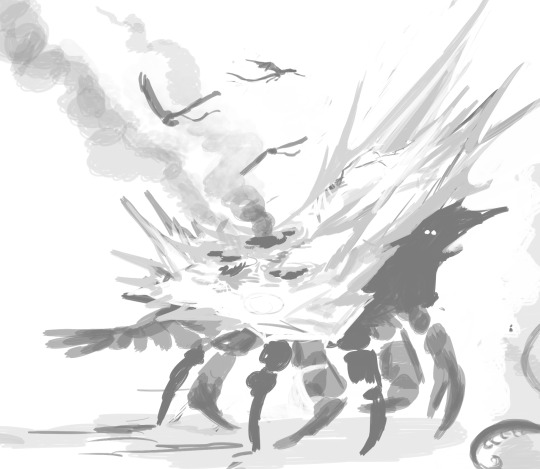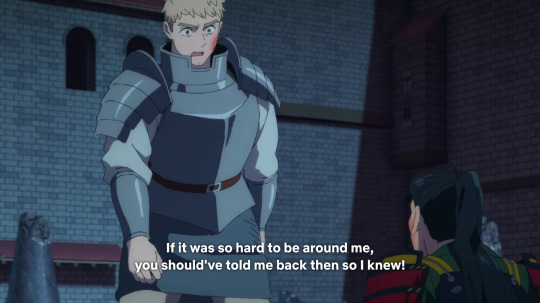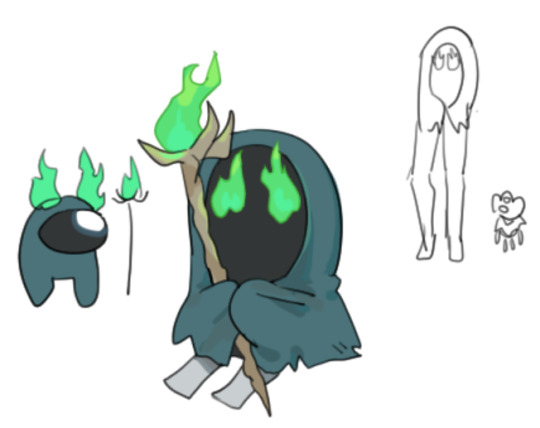Text
Guys. I can feel it already. THIS is the year. This is the year that Jonathan Harker will go on his business trip with no issue. Just a lovely train ride through Europe where he collects paprika recipies for Mina, meets some friendly, living people looking to buy properties in England, and then returns home safely.
Free him from the time loop.
7K notes
·
View notes
Text


what do you meaaaaaaan this is baby sturgeons youre lying to me.... you just Shrunk him
18K notes
·
View notes
Text
Made the worst brownies ever created just now
90K notes
·
View notes
Text
I think I know why I love the Horizon story so much.
It's narratively post-apocalypse, but not thematically post-apocalypse.
This story isn't about a world that ended, but carries on under new laws and understandings, this is about an entirely new civilization. The history is gone, so far gone for so long that even if it were recovered now, none of it would matter because culture and science and art have already been rebuilt from scratch.
It also, unlike most post-apocalyptic stories, doesn't almost exclusively portray humanity as a plague and an enemy of life and the natural world. In this case, life didn't endure despite humanity, life endured BECAUSE of humanity.
The Horizon story is a fun, emotional, action-packed chronicle, but it's also a love letter to humanitarianism, and how important it is that we never give up no matter how hopeless the situation seems. We are a part of the natural world. We are a part of nature itself, and we are not the enemy of life. We, on our best days, are life's custodians.
882 notes
·
View notes
Photo

Lady Maria of the Astral Clocktower, Vileblood Student of Gehrman, descendant of Castle Cainhurst
3K notes
·
View notes
Text
Little addition: The Battle of Talas story is a popular explainer for the spread of paper-making into the Islamic world, but the craft had already been practiced in Central Asia long before that! We know this because the native Sogdians at Mount Mugh, in modern Tajikistan, left a trove of paper documents while they were fighting the Muslims three decades earlier.
One particular innovation the folks there came up with was replacing Chinese mulberry fibre with cotton fibre from discarded rags, which was both easy to work with and resulted in a remarkably soft end product – though cotton wasn't that widespread at this point (certainly not in Europe until they began importing it at a large scale from India in the 18th century), which might or might not make it the best fit for your setting. For less premium alternatives, you might also want to look at paper made from linen or hemp, which were very widely grown across the Mediterranean world.

okay what did i miss
(yes some of these overlap and some are suppositions. for example if parchment is always used for ephemera, rough drafts, notes, and never re-used or re-purposed, we can also assume that the author is unaware of wax tablets as a concept)
5K notes
·
View notes
Text
People who think this planet was created for humans to be ours are so wild to me
156K notes
·
View notes
Text
The one bizarre thing to me about textiles is that warp-weighted weaving is at least 6500 years old, but our oldest knitted artifacts are only ~1000 years old, and crochet 200 years old. Even though you need less equipment to knit (two sticks) or crochet (one hook) compared to warp-weighted weaving (frame, loom weights, batting, heddles). Why the big gaps between these inventions? And why did each one appear and spread when it did?
4K notes
·
View notes
Text
Look, I agree that trying to sell folks on original fiction by citing fanfic tropes is asinine, but at least "oh, it's got enemies to lovers!" tells you something substantive about the plot and characters. I once had somebody try to convince me to read a work of original fiction by telling me that it has a romance with a height gap.
4K notes
·
View notes
Text
Today I am thinking about weaving.

I can knit and crochet, but those crafts didn't exist in Roman times. Any historically accurate Roman cloth must be woven. So when a little potholder loom jumped into my shopping basket for 50 cents, it felt like a sign I should learn.
One potholder that was 50% yarn and 50% weird gaps later, I looked up a tutorial, and realized why the damn thing was 50 cents. I needed a better, more adaptable loom. And, because I am a cheapskate and slightly loony, I decided to make one instead of buying it.

So, how does this thing work?
First, you string the warp threads up and down, around the pegs. Here, I made a zigzag shape. Then, you use a needle or shuttle to weave more yarn over and under the warp, horizontally, back and forth. This produces woven fabric.

Some looms weave from the top, some from the bottom. This Greek urn shows two weavers working from the top. The left weaver uses a rod to compact the woven fabric upward, keeping it even and sturdy. The right weaver is passing an oval-shaped shuttle through the warp threads to form another row.

Most Roman looms would have looked like this, with the finished cloth at the top. Unlike my looms, these are warp-weighted. That means you keep the warp yarns taut by hanging weights at the bottom, rather than through a bottom row of pegs.
Warp-weighted looms also have a big advantage over my little potholder loom: you can easily create multiple sheds.
A "shed" is a temporary gap between lifted strands and non-lifted strands. Instead of having to go over and under each strand individually, you raise the entire shed, then pull the shuttle or needle straight through. This saves lots of time! Then, to weave the next row, you close the shed, lift up a different set of threads to create a new shed, and send the shuttle/needle through the other direction.

On a warp-weighted loom, the sheds are opened by loops called heddles (H), which are attached to a heddle rod (G). When the rod is down, shed (1) is open (middle diagram). When you pull the rod up, shed (1) closes and shed (2) opens instead (right diagram). Most warp-weighted looms also have a pair of forks you can rest the heddle rod on, to free your hands.

Here, there are three heddle rods and sets of forks, the heddles are white, and the warp thread is red. This gives you four different sheds, and the potential to weave very complex patterns indeed. Not bad for a device invented over 6500 years ago!
I liked the multiple heddle-rod design so much, I tried incorporating it into my DIY loom, too. I've tested both yarn and paperclips as heddles:

I actually got both sheds and heddle-rods working, too. Which is pretty cool for a lap loom - every other lap loom I found only has one shed, so you have to go over-under the individual threads on alternate rows.* More time-consuming. However, the sheds here are narrow, and I'll need a smaller and smoother shuttle to pass through them smoothly. This wouldn't be an issue on a warp-weighted loom, where the warp hangs freely downward, and can move more flexibly with the heddles.
Anyway. I may get a "real" loom at some point, but I wanted to build one first, and I think it gave me more appreciation for just how resourceful ancient weavers were. They created technology, clothing, and artwork out of very basic materials, and civilization depended on these skills.
Now, I need to go finish the...whatever the hell it will be. Big thanks to Wikipedia and to the lovely Youtubers who make this craft easier to learn. I think it'll be a lot of fun.
(*Edit - found out a rotating heddle bar can make two sheds on a lap loom! Exciting!!)
1K notes
·
View notes
Text
Y'all, the world is sleeping on what NASA just pulled off with Voyager 1
The probe has been sending gibberish science data back to Earth, and scientists feared it was just the probe finally dying. You know, after working for 50 GODDAMN YEARS and LEAVING THE GODDAMN SOLAR SYSTEM and STILL CHURNING OUT GODDAMN DATA.
So they analyzed the gibberish and realized that in it was a total readout of EVERYTHING ON THE PROBE. Data, the programming, hardware specs and status, everything. They realized that one of the chips was malfunctioning.
So what do you do when your probe is 22 Billion km away and needs a fix? Why, you just REPROGRAM THAT ENTIRE GODDAMN THING. Told it to avoid the bad chip, store the data elsewhere.
Sent the new code on April 18th. Got a response on April 20th - yeah, it's so far away that it took that long just to transmit.
And the probe is working again.
From a programmer's perspective, that may be the most fucking impressive thing I have ever heard.
92K notes
·
View notes
Text




Various critter designs based around the whole idea of 'living islands'
1K notes
·
View notes
Text



Celeste dos Cravos
An illustration commemorating the 50 years of the Carnation Revolution that took place in Portugal on the 25th of April of 1974, and the woman, Celeste Caeiro, who gave the revolution its name with a simple gesture :)
25 de Abril sempre! Fascismo nunca mais! ✊
Art Prints: inprnt & Redbubble
2K notes
·
View notes
Text
humans really went off with building on precipitous rock faces
11K notes
·
View notes
Text




every autistic person watching this episode of dungeon meshi:

52K notes
·
View notes
Text
my groundbreaking historical method: trying to rationalise everything in terms of corruption
94 notes
·
View notes







